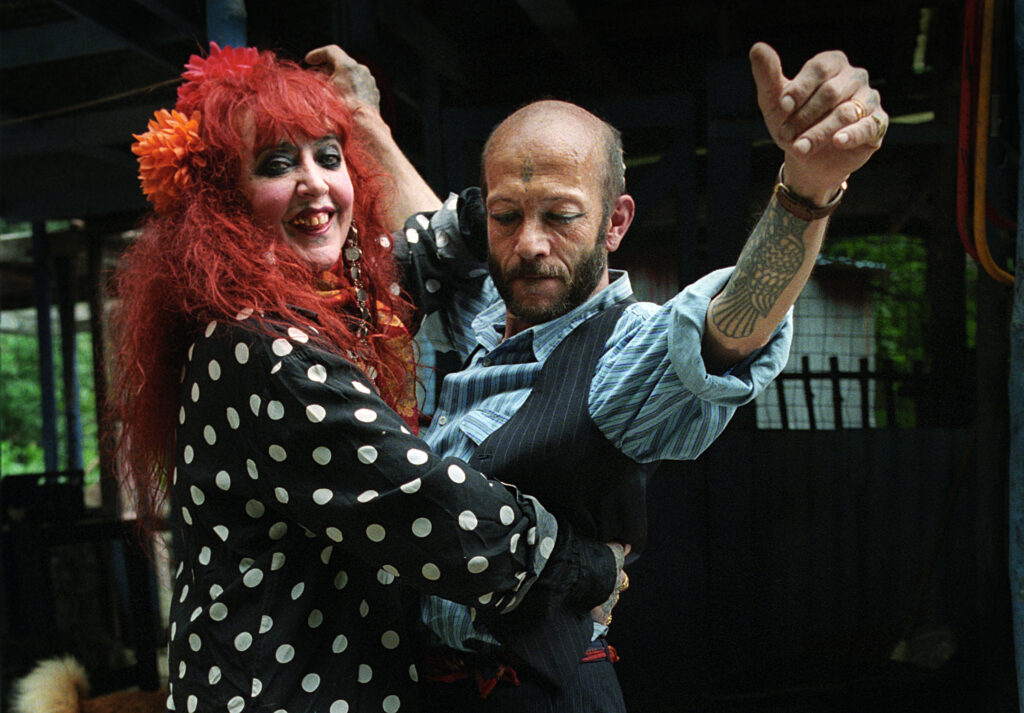Interview with Gianni Menichetti
The French version is available at La Spirale
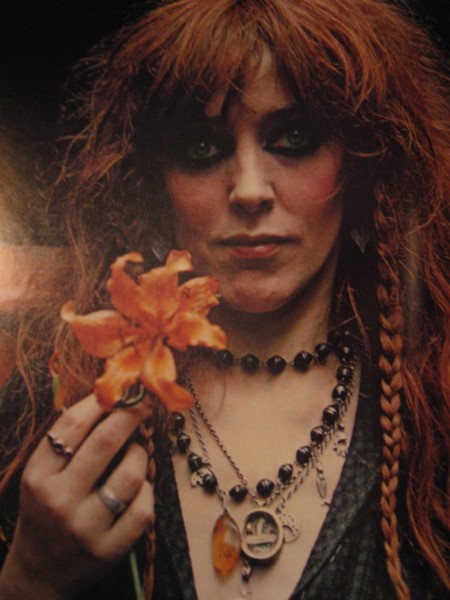
Vali with lily, © Copyright Mary Ellen Mark Library, www.maryellenmark.com
The art of Vali Myers is inseparable from her flamboyant personality. Having left Australia in 1950 at the age of 20, she came to live in Paris to continue her career as a dancer. But her life turned out to be rather difficult in the capital of France. Often living on the streets, she spent the days drawing in Parisian cafes. In spite of these hardships, her free spirit and exceptional personality led her to forge the ties of friendship with Jean Cocteau, Jean Genet, Tennessee Williams and with several other illustrious personalities of the time. At that time, Vali Myers also met the artist Mati Klarwein, who became her friend for life, and Ed van der Elsken, a future renowned photographer, who celebrated her in a photo novel « Love on the Left Bank « . Later, she moved to live with her husband Rudi on the Amalfi Coast, where they settled down in a “Moorish Pavilion,” a late 18th century dome in the wild ‘Il Porto’ Valley, near Positano. There, she devoted herself completely to painting, projecting her dreamlike visions onto her drawings. Dressed like a Gypsy, with a tattooed face, Vali Myers was quickly named by the inhabitants of the village « the Witch of Positano ». Living far from the bustling city life, she was visited by stars like Marianne Faithfull, Mick Jagger and Donovan. Over time, she began to share her life between the wilderness of Il Porto Valley, where she lived with her new companion, Gianni Menichetti, and lots of animals, and the Chelsea Hotel in New York. At that time, Vali was a friend of William Burroughs, Dee Dee Ramone, Chris Stein, and also Patti Smith, who asked Vali to tattoo her, and many others. Among the remarkable people Vali Myers met at the time was Salvador Dali who greatly appreciated her drawings and encouraged her to exhibit them in the Netherlands. He was not mistaken, her drawings were a big success in Amsterdam. Another valuable piece of advice was given to Vali by Andy Warhol. The father of American Pop Art advised Vali to make serigraphs of her works and to sell the multiple prints. That allowed her to earn a living, while keeping her originals.
Vali Myers died in Melbourne on February 12, 2003, shortly after being diagnosed with cancer, aged 72.
Last summer, during my trip to Positano, I visited Gianni Menichetti, who still lives in her house in the Valley. This interview is the result of that unforgettable encounter which gave me an insight into the life of this timeless artist who continues to inspire new generations. I would like to thank Gianni very much for welcoming me and sharing his memories of Vali Myers, as well as for authorizing me to take some photos of the Moorish Pavilion which illustrate this interview.

Gianni Menichetti at the Moorish Pavilion, 2022 © photo © Alla Chernetska
Q. Could you tell how you arrived for the first time in the Valley? Did you have a feeling that you would stay there for a lifetime?
G.M. I have always said: “It was the hand of Fate that got me here”. When I came to Naples at the end of 1970 (I’m originally from Tuscany, born near Siena, and I lived in Florence between the age of 4 and 18), I wanted to study at the Oriental Institute of Naples’ University. I was very passionate about Tibetan culture. I followed some lessons without enrolling in the courses. I hardly had a penny in my pockets, I lived here and there, that winter, like a stray dog. At the Oriental Institute I met a Tibetan Lama, Namkhai Norbu, who later rose to the level of “Rinpoche” (which means “jewel”). Knowing that I was absolutely vegan in those days, he introduced me to a Neapolitan jeweler friend of Vali, who brought me to meet her in the Valley in early February 1971. It was after dark when I arrived with Vali’s friend. Such a loud thunder of dogs barking greeted us at the garden gate! This changed my life forever after. It was a short encounter. Vali was very open and welcoming. I don’t want to say that that this blew my mind, but it was the end of an era for me when I met Vali for the first time. Then, a little while later, when she went to New York, I got a letter from her Neapolitan friend, asking if I could come to look after the animals. I got the letter at ten in the morning and at half past eleven I was at the train station.
I was in the Valley for two weeks, between March and April. After some travels, I came back here in May, and lived in a cave for a month. After half a century, I say that I love this place more than myself, and I hope one day I’ll turn into a cliff. I call this place Vali’s Valley; I’m married to its wilderness. You cannot tell the story of your life in five minutes, but that is how I came here in the beginning, and here I am, 51 years later.
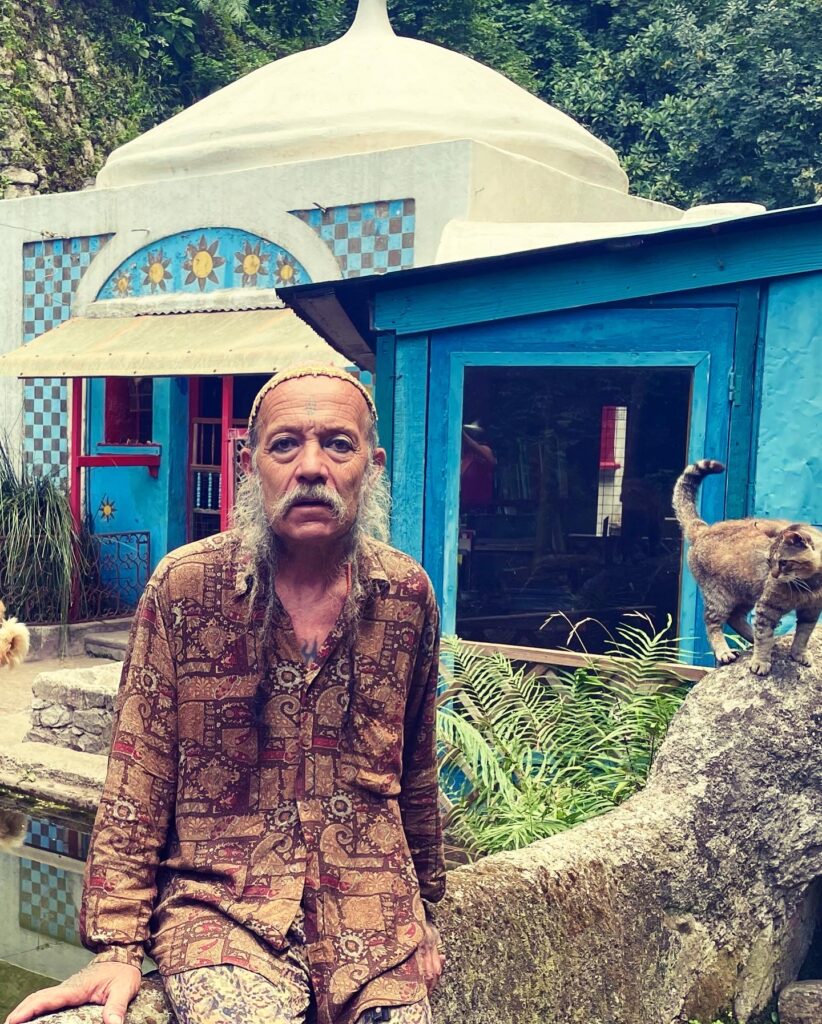
Gianni Menichetti at the Moorish Pavilion, 2022 © photo © Alla Chernetska
Q. In your book you relate that there was nothing romantic about Vali’s life in Paris, it was a very hard time, but she met incredible people like Jean Cocteau, Jean Genet, Django Reinhardt. Among them was a remarkable artist, Mati Klarwein. They remained friends for life. But do you think that in spite of those hard times, there was something about Paris that inspired Vali, something that influenced her future life?
G.M. I always said that the hardest times in one’s life are the most important. When everything is lovely nothing comes out of it. Vali lived in a very hard way, often she didn’t have a place to go in the early 1950s. It was not like in the song “La vie en rose”. She lived a street life, hard to imagine. But because of that, she met remarkable people. By the way, Vali met Django Reinhardt, with his gypsy family in Belgium. She often didn’t have a place where to sleep, and yet, when she was in a café, she could not fall asleep, otherwise she would have been kicked out. When she came from Australia, she had very little money with her, and she spent it in the first days. She had to take a train from Marseille to Paris. She was absolutely broke in those days. She wanted to follow her dancing career, but instead she was living a wandering life, and yet she started drawing during her first year in Paris.

Vali Myers, ca. 1949 by Norman Ikin
Q. Vali began to draw in Parisian cafés. What do you think inspired Vali to create her first drawings?
G.M. She liked drawing when she was a little girl. She always had a passion for drawing. Then at 14, she stopped going to school and started to work to pay for her dancing lessons. But when the Melbourne Ballet Company knew that she had to work to go to their lessons, they waived her fees. She always said that she went to Paris in 1949, but I found an article dated 1949 where she was dancing with the Melbourne Ballet Company, so it must have been the following year that she went to Europe. I must say that her mother always encouraged her for whatever she wanted to do. Her father was very Victorian, with a high moral tone, and when she was 14-15 he used to say to her: “You are running in the streets like a dog!” And when she went to Europe, in those days by ship, her father, shaking hands with her, said: “If you are in trouble, don’t write home about it.”
Q. One of Vali’s best friends was Mati Klarwein. In 1972 they were together in the desert of Niger to make the film Milk and Honey, with the Wodaabe tribe. What happened to this film? I can’t find any information about it.
G.M. The first time Vali came to Positano, it was in early summer of 1952, with two friends: Mati Klarwein and a woman friend from Vienna. They met for the first time in Paris, and later in their life they met each other as destiny ruled, but in Paris he was one of her first friends. The film project was a total failure.

Blue Fox, stylo, encre noire, aquarelle, tempera et feuille d’or, © Copyright Vali Myers Art Gallery Trust
Q. And Mati Klarwein was the first person who called her Vali…
G.M. Yes, that’s right, because in Australia she was called Val. The film that they were supposed to make in Niger never came out. Their car went off the road and everything went wrong. There in Niger, where she spent three weeks in the Spring of 1972, she was with a native Wodaabe man, Jibo. Only two people tattooed Vali on her face, Jibo the Wodaabe tribesman, with three dots on one cheek, and me, the same on the other cheek. I tattooed Vali’s hands and feet, and more than that. She taught me how to tattoo. You know, in India, they believe that when one dies, the soul keeps the tattoos. When Vali was in the desert, with the Wodaabe, I had a nightmare, and that coincided with the time when the car driven by Mati went off the road, with Didier Leon, Vali, Catherine Milinaire and others of the troupe. Luckily, they suffered only a few minor wounds. Vali’s portfolio with her drawings flew off twenty meters away, but it was unharmed. Vali considered her drawings like her babies, and took them wherever she went. Some people think that she made a lot of drawings, but in her whole life, from the 1950s to the end, their number comes up to about 130. Most of them are small, often unfinished drawings. She could be working for years on a small drawing, as on Lammas Tide, for six years, or Death in Port Jackson Hotel, for two years.
Q. Mati Klarwein introduced Vali to the underground photographer et filmmaker Ira Cohen. I saw Vali in one of his psychedelic photos. Could you tell me about their friendship?
G.M. Ira was a good friend of hers. He came here once. Ira Cohen introduced Vali to R.J. Reynolds of the R.J. Reynolds Tobacco Company. He was the head of this company. Vali showed him her drawings, and he loved them, and he chose the drawing Foxy. At that time, she asked 1500 dollars for it and she said to him: “Am I asking too much?” and he answered: “No, you are asking too little”.
Q. Vali admired the outlaw heroes, like the Sicilian bandit Salvatore Giuliano (portrayed with Gaspare Pisciotta in her drawing Montelepre), Sardinian outlaw Graziano Mesina (in her drawing Teresa), the famous member of IRA, Bobby Sands, the Australian outlaw Ned Kelly, and the samurai poet Saigo Takamori. She was a close friend of Abbie Hoffman, the activist and yippie leader pursued by the American government for protesting against the Vietnam war. Could you tell me about their friendship, they had quite different lifestyles?
G.M.Yes, she always loved outlaws, the honorable ones, like those you have mentioned. Human laws can change in a very brief time, and what was absolutely against the law, in no time could become “normal”. The outlaws are outside the law anyway, they have their own laws and ethics. They can be violent, but have their principles, like Robin Hood who stole from the rich and gave to the poor. Then he stole from the poor who had become rich to give to the rich who had become poor… (laughter) This funny nonsense doesn’t come from Vali, of course.
Carole Ramer, who was the right hand of Abbie Hoffman, finished in prison for him. She came here, in the Valley, and stayed for several days, a lovely person. Abbie and Vali were going through Chinatown in New York and Vali saw two ducks hanging from the sign of the restaurant, that were not real ducks anyway, and Vali said: “Poor ducks!” And Abbie said: “Why do you worry about the ducks? You should worry about people!” What I always admired in Vali was her attitude of a great animal goddess. If she saw a little bee fallen in water, she saved the creature and gave it sugar or some drops of honey which was a luxury in the old days. With humans she could be the most generous, outgoing, incredibly beautiful person or extremely ruthless and devastating. I have known both…
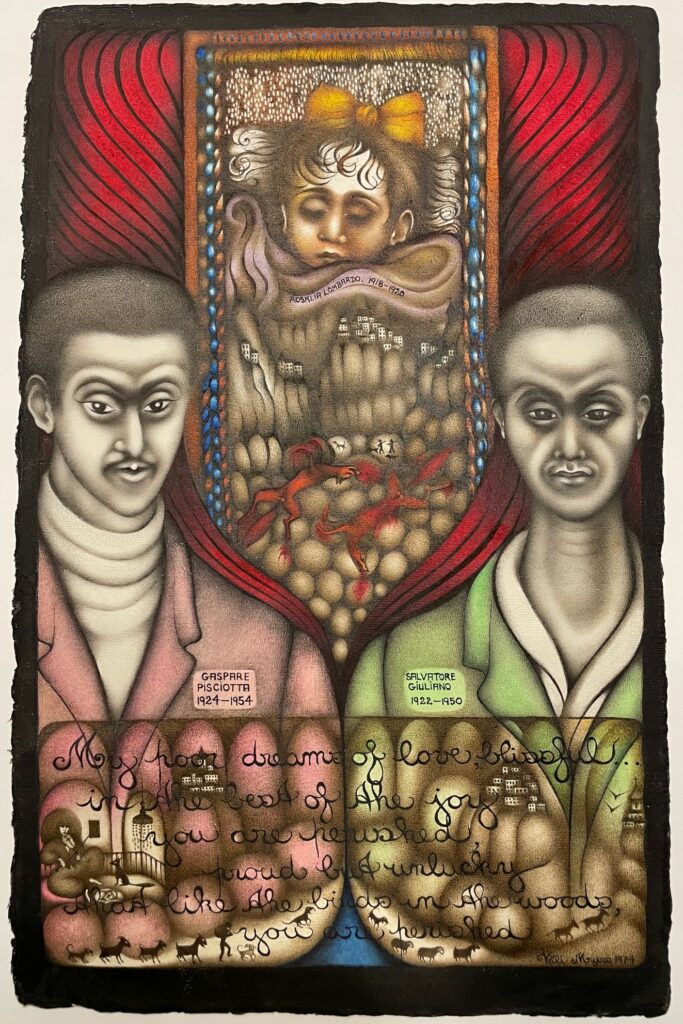
Montelepre, 1973-1974, stylo, encre noire, sépia et aquarelle, © Copyright Vali Myers Art Gallery Trust
Q. Among Vali’s friends were Marianne Faithfull, who came to the Valley with Mick Jagger, and Donovan, who in 1967 asked Vali to dance for him at his concert at The Royal Albert Hall in London.
G.M. Yes, once Marianne Faithfull came with Mick Jagger. Vali was as always, in her “cage” by the loft bed. Mick Jagger was very well behaved, he loved literature, especially ancient poetry. Vali in those days didn’t follow the news and she hardly knew who he was. She said to him: “And what do you do, play guitar?”
Marianne Faithfull came here in the late 1960s, but never again. Then she met up with her in Australia. She invited Vali to one of her concerts.
The first time Donovan came here, around the second half of the 1960s, as the dogs were barking, Rudy, Vali’s consort at that time, went to the gate to see who it was. “I’m Donovan”, he said, and Rudy answered: “I’m Rudy, fuck off,” because he did not know who he was. But afterwards, they became friends. Donovan had long hair and when he came to the nearby town, they didn’t want to let him to stay in a famous hotel, so much for “the good old days”. When Donovan invited Vali to dance for The Season of the Witch, it was the first trip in several years for Vali, except for going to the Gypsy Festival at Saintes-Maries-de-la-Mer. He sent Vali a ticket to go to London, only for one performance, dancing for a single song, at the Royal Albert Hall.
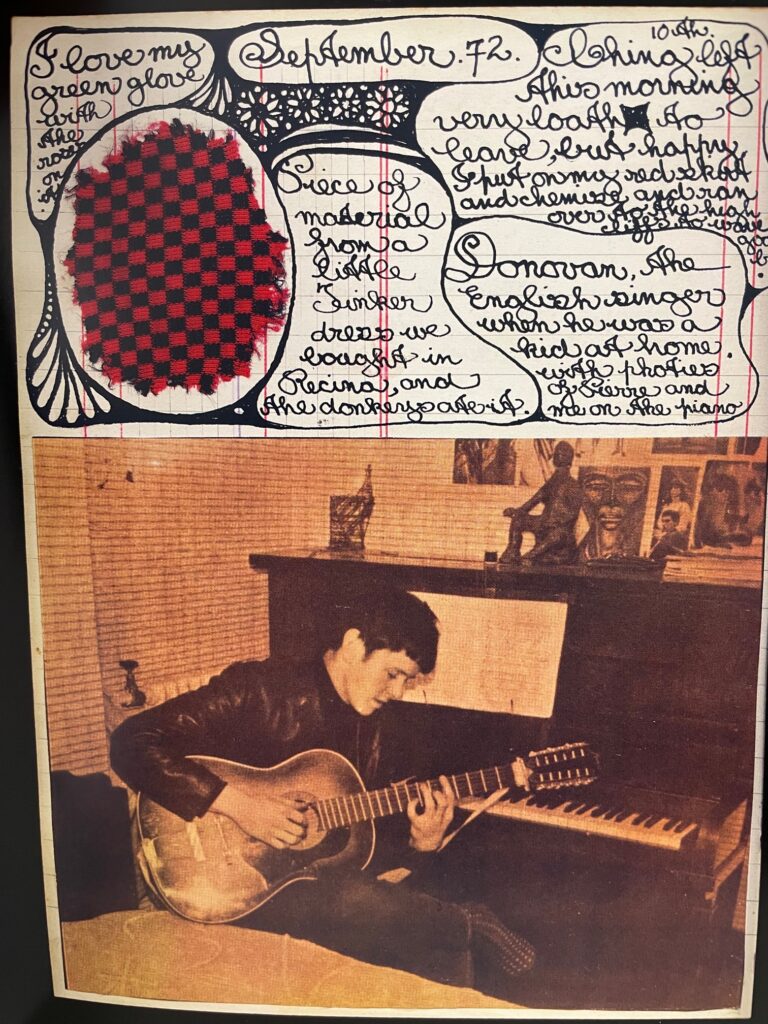
Donovan, Visual diary September 1972, © Copyright Vali Myers Art Gallery Trust
Q.Vali had a very strong personality, and, at the same time, we can see many symbols of protection in her life. She liked to sit and draw in her “Cage”, upstairs by her loft-bed, because the cage protects the heart. Her make-up was a kind of war-paint which also gives protection. From what did she need to be protected?
G.M. It’s a funny thing, because she came out with sentences like this: “The rib-cage is the cage that protects the heart”. She came out with incredible sentences. She was very vulnerable while she was getting over opium in her first years in the Valley. When you speak about the protection of the cage, the cage is associated with prison, but then, when you think about being a prisoner, aren’t we the prisoners of our destiny? That’s from me… But she gave me a lot of wisdom in that way. The cage is something that can be awful, but something that protects. If the heart did not have a rib-cage, forget it…

Vali Myers’ cage at the Moorish Pavilion, 2022 © photo © Alla Chernetska
Q. Vali loved the book Moby Dick by Herman Melville. She wore, as a pendant, a little whale, that she carved out of bone. Did she identify herself with a whale, strong and powerful, but who was always obliged to battle for its life?
G.M. Vali made several drawings inspired by Moby Dick. She identified herself with the whale. She liked when finally, the whale takes all the human hunters with itself, down into abyss. For me, Moby Dick symbolizes the inner power. When everybody is against you or doesn’t support your manner of existence, if you follow your interior power, you will survive despite everything, as Vali did, or go down with pride… There is a beautiful saying in the beginning of Moby Dick: “I’ll try a pagan friend, thought I, since Christian kindness has proved but hollow courtesy.” Ahab, going down with the whale in his crazy hunt, represents for me the madness of the human world.
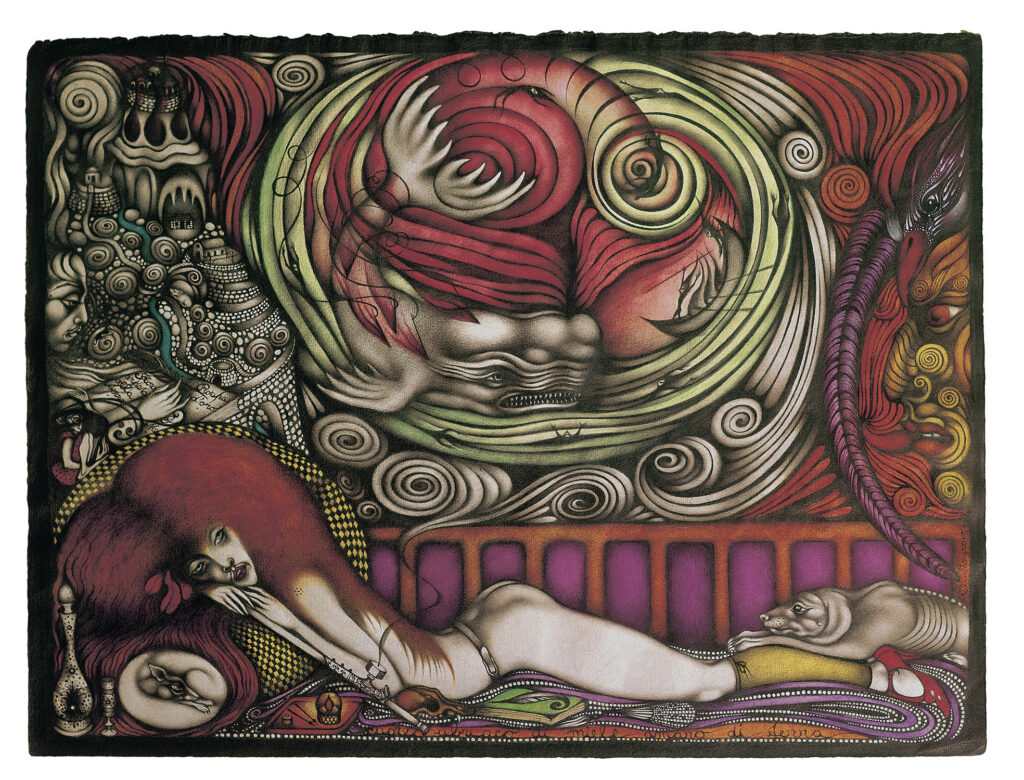
Moby Dick, 1972-1974, stylo, encre noire, terre de sienne brûlée, aquarelle et tempera, 30 x 40cm, collection privé, © Copyright Vali Myers Art Gallery Trust
Q. The people want to destroy what scares them. Vali also was a very strong person, very flamboyant, but she scared some people. The local municipal administration wanted to get rid of her because of her appearance and life style. She was pursued also like Moby Dick. What is interesting, is that those kinds of people, who are different and are rejected by society, if they stay the way they are, will become later a guiding light for the other people…
G.M. You know, “La vie c’est la guerre, life is a battle ! » But you must know, that behind all the troubles she had to fight against in the 1960s, people wanted to speculate on the Valley. They wanted her out of here, to cut down all the trees, etc. And Vali fought, a hell of a fight. She said: “This forest will not be cut down! ”
Q. And now, is it a protected area?
G.M. On paper it is protected, but I’m afraid that “ Après moi, le deluge!” (after me the deluge). I hope not… I also fought alone after Vali passed away. And it was a very difficult fight for five years against crazy projects that would have ruined the Valley. But I was helped by W.W.F. and the press, especially by the journalist Maria Rosaria Sannino, who wrote for a leading newspaper. She was wonderful! When I had practically lost all hope, she said: “You will see, we’ll win!” And we did! I hate bureaucracy, I’m not the only one, for sure! You know there were so many papers, I would say volumes, from ecological foundations, from here and there, and then, being interviewed by the national TV, did more than all these papers…

The Valley, Positano, 2022, Photo © Alla Chernetska
Q. You say that Vali always liked to be dressed, never naked. What other taboos did she have? She didn’t accept the rules of society, but she set up her own taboos…How do you explain these contradictions? Did she want to create her own world with her own rules?
G.M. She was amazing, but at the same time unpredictable. She always wore long dresses and gaiters … she went barefoot, but otherwise you never saw her naked. I think that people today go to another extreme, but to walk around in underpants doesn’t mean to be free. The freedom of spirit is something completely different. There is a wonderful story with John Lennon! It was in 1970, the show called Up Your Legs Forever, where some people would show their bare legs. In this case, Vali showed them but with her gaiters on. Somebody said: “No, you have to take your gaiters off. Vali says: “No way!” And then, Lennon said: “No, leave her alone!” She could be very extravagant, but she had her own taboos. And yet, in most of her self-portraits you can see her lying, or standing, stark naked. Once she said to me: « A real woman is always naked, she’s afraid of nothing. »
Q. She always needed to be dressed as a protection or because her clothes were part of her personality, like the tattoos?
G.M. You can’t talk about Vali in a logical manner. She had her own principles, her own beliefs, and she was very wild in spirit. She learned how to tattoo from a Mexican in the Left Bank in Paris, I don’t remember the name. And she tattooed her own face, except for the three dots on one cheek from the Wodaabe tribesman, and the three dots on the other that I have done. And she had a lot of others, the names of her favourite animals on her body that I did.

Portrait de Vali Myers by Ed van der Elsken, Copyright © Ed van der Elsken / Nederlands Fotomuseum
Q. On one hand, Vali wanted to isolate herself, to create her own world, and on the other hand, she got to know a lot of incredible people, as if she needed two parallel lives. How do you explain this ?
G.M.I wondered how, after living here, in the wilderness, surrounded by these high cliffs, she could go to New York and live among so many people… Her answer was: “What is the difference? Instead of high cliffs I have the skyscrapers, and instead of dogs there are people”. But believe me, she loved her dogs and animals much more…
Q. There are a lot of spirals in her drawings. What symbolical meaning did she give to these spirals?
G.M. Vali didn’t like straight lines. She loved spirals because it is going in and going out of oneself, I would say…
Q. Death in the Port Jackson Hotel is a film portrait of the Australian artist Vali Myers by Van der Elsken. He films her while she brings back memories looking at photographs that are shown to her in 1972. The film’s title is the same as her drawing made in 1969. Very enigmatic drawing. Is there a story behind it?
G.M. It’s a kind of suicide, that means the change in her life. She did this drawing before I came here, she worked on it for two years. Vali herself explains her drawing this way: “Before leaving Australia for France in 1949, I spent the last week in my hometown Sydney, at the Port Jackson Hotel. This drawing, which took me 2 years, is the suicide of a 19 year old girl, but also a rebirth, a flaming one. Above her is the face of a Queen wearing toad earrings and on both sides of her bed are scenes from the Valley. I dedicate this drawing to a great Eskimo hunter called Little Seagull (Rasmussen, Greenland Stories) and to Tiluwiga, a Chukchi of Siberia, who after years of suffering changed from male to female and became the great shamaness of her tribe (Bogoras, The Chukchi). Wisdom that is gone, gone to the beyond and beyond the beyond”.

Death in Port Jackson Hotel, 1968-1969, stylo, encre noire et aquarelle, 49 x 33cm, collection privée, © Copyright Vali Myers Art Gallery Trust
Q. In Vali’s drawings we see characters lying in a dreamy position, or as if they were dying. Are they inspired by her life in Paris, when she was smoking opium in her room?
G.M. Well, at that time she lived very much the life of a recluse…

Opium, by Vali Myers, © Copyright Vali Myers Art Gallery Trust
Q.There are a lot of skulls in her drawings. Dream within a Dream, Mexican Afternoon, Vera Petrovitch. What was Vali’s attitude towards death?
G.M. Vali didn’t inform her family that she was dying, they heard this from the news on television. I was one of few people who could call her. Vali had a very good friend, Grazyna Bleja, “Misiu”, so faithful to her until the end. Vali gave her one of her drawings, but she gave it back to the Foundation. A really honest, beautiful person, she didn’t want to acquire anything from her. She told me that when Vali was in hospital, a woman friend called her, and when she heard that Vali was going to die, she said: “Oh no!” And Vali answered: “Don’t worry, baby! Dying is beautiful, I wish I could do it a few more times”. And when she told me: “Well, I’m in a hospital, I shall die here.” I also said: “Oh no!” And she answered: “What did you think, that I would live forever?”
Q. Being very flamboyant and wearing colourful clothes, Vali was attracted by the dark side of things, as you say in your book…. Did she want to bring light through darkness or did she feel comfortable on the dark side of consciousness?
G.M. I can quote some lines of Edith Sitwell that Vali loved very much, in Paris already: “He lies embalmed by bees / the sweetness lapping over him, / with only Darkness for a lover.” That came from the Paris days, quiet, still, and dark. But she often said : “Light shines in Darkness”. Can you imagine, she was living in the South of Italy and she hated bright sunny days. She liked when the night was falling.

Black sun, 1971-1972, par Vali Myers, © Copyright Vali Myers Art Gallery Trust
Q. Sometimes we see in Vali’s drawings a kind of double of her characters, like a human and his soul (Chelsea Hotel, 1971-72; Death in Port Jackson Hotel 1968-69). Where does it come from? Is it connected with her dreams or does it mean the interior journey?
G.M. Just what you said, it is connected with her dreams and inner journey. She often cited E.A. Poe’s poem A Dream within a Dream.
Q. Vali was very close to the Gypsies, she went to the Festival of Madonna dell’Arco, near Naples, year after year, to meet them there. There are some drawings dedicated to gypsies, as Madonna dell’Arco, Fuiente. She dressed as a Gypsy herself. Is there some crucial event connected with Gypsies in her life?
G.M. She always admired Gypsies. In the early 1950s, she met Django Reinhardt in his family in Belgium. In the 1960s, she went to Saintes-Maries-de-la-Mer to their music festival, where so many Gypsies came from all over.
Q. The statue of the Black Madonna in Vali’s cage was very important for her. Could you tell me about this sculpture?
G.M. It was given to her by a Canadian friend in the early 1960s, an antiquarian who found this fabulous Madonna in the deep South of Italy.
Q. Did Vali decorate the Madonna herself?
G.M. Except the black around the eyes and necklaces and gems, not much. I believe she came with her beautiful black and gold embroidered mantle, crown and the heart with the seven daggers. The funny thing isthat the Madonna had such a pale face! Now she looks so dark because of the smoke from the fire in the house during Winter for the past 60 years.
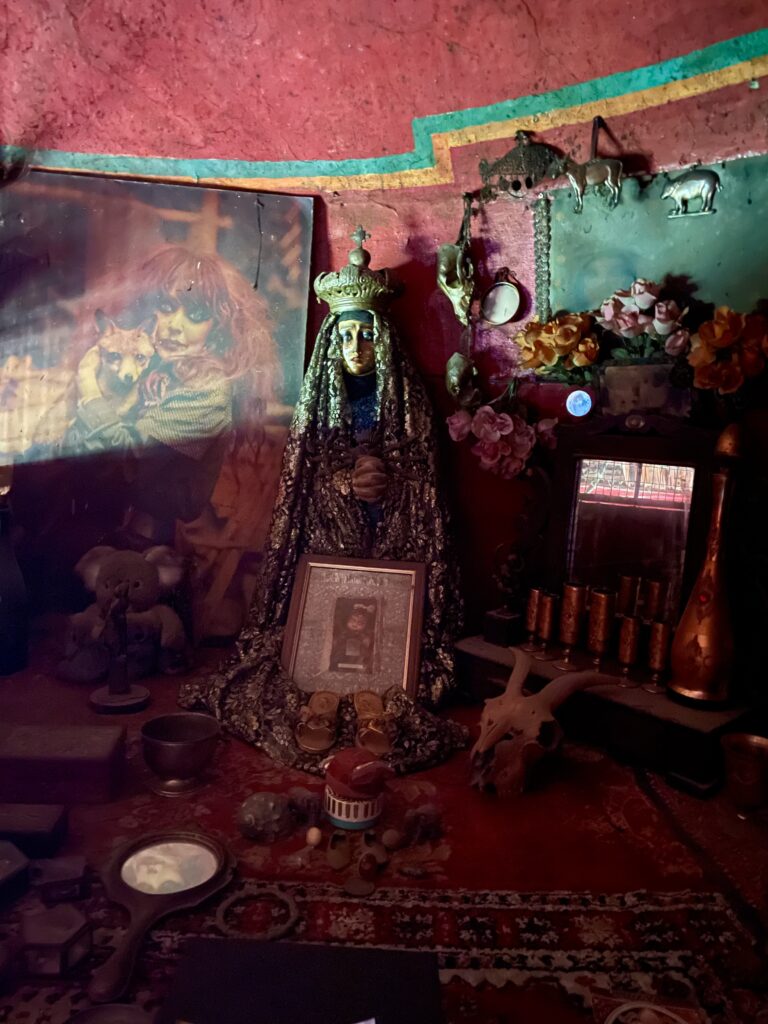
Black Madonna in Vali’s cage, 2022 © Alla Chernetska
Q. In fact, the Black Madonna is called “black” because of her sorrows, that’s why she is often dressed in black.
G.M. That’s right. Madonnas with dark faces must be very rare, I believe because they came from the Christian Churches in the Middle East. It’s a real mystery about the worship of the Black Madonna…
Q.There are always lots of animals in Vali’s drawings. Are the animals she had or are there the animals which also had a symbolic meaning ?
G.M. The animals you see in her drawings are from her own animal family, or the wild ones living in the Valley. The fox is her own soul. You know, Foxy lived the longest life a fox can live, fourteen years.

Vali Myers by Marco Bakker, 2000 © Copyright Marco Bakker
Foxy was as her natural daughter. She was the only animal that Vali didn’t want to be buried. The other animals I buried in the garden and all around. She wrapped her in beautiful cloths and I put her on a tree for nine months, she was embalmed naturally. A box was made in the nearby town, and the carpenter who made it didn’t want to be paid for this beautiful chestnut wood sepulchre. I went to Naples and had made a plaque engraved with what Vali wished to be written: Foxy (1965-1979) Only beloved daughter of Vali Myers. And when a friend of Vali from Australia, Julia Inglis, came to see me, she brought me a pinch of Vali’s ashes. Now in Foxy’s box, mother and daughter are together again.

Vali with her fox (Foxy) 1972, by Rudi Rappold, © Copyright Vali Myers Art Gallery Trust
Q. And you, when did you start drawing? What inspired you?
G.M. I started quite late. In the 1970s and 1980s the animal family was so huge, and I never stopped working. I started to draw in 1990. My first drawing was a portrait of me with a small falcon, a kestrel, whom I saved. The creature was wounded in a wing surely by some damned hunter from the village above. And that’s how I started to draw. My first exhibition was in 1991. Life is so unpredictable. About three weeks before the opening, I was given some lousy wine at the music festival nearby, and coming back at night, I fell at the entrance of the Valley and broke several ribs. But the exhibition was very successful, and the first night I came back with my pockets full of money. I called Vali to tell her the news, but she couldn’t pronounce her words properly. “What happened love?” I said. She had three seizures a few days before. That’s how things happen in life. You have a success, and then everything seems like a joke. I found somebody to come and feed the animals and went to see her in New York for ten days. On my way back, I stayed in London for one day to see the works of William Blake but I couldn’t because of the blackout in the Tate Gallery. So I went to the British Museum, to see the ancient illuminated manuscripts
Q. Could you tell me about your trips to India? When did you go there for the first time? What were you looking for and what kind of inspiration did you find there?
G.M. It was during what I call “my self exile”. The first time I went to India was in 1993. There I found my soul and great inspiration for my poetry. A collection of my poems is entitled: The Land of Kali.

Gianni Menichetti, Kali running with fox, 1996, 30×21 cm © Copyright Gianni Menichetti
Gianni Menichetti, Kali’ attendant with watch dog, 1995, 28,5 x 20,5 cm © Copyright Gianni Menichetti
Q. Often Vali was associated with hippie philosophy, even if she anticipated the hippie movement by almost 10 years, and she inspired a lot of well-known personalities of the 1960s. But when she was living at the Chelsea Hotel in New York, it was the era of punk, quite opposite and even hostile to hippie values. But she was a very good friend with Dee Dee Ramone, Debby Harry and Chris Stein from Blondie (he named his daughter Vali), Eileen Polk who made a lot of photos of punk personalities and worked at the punk boutique Revenge (she met Vali there), Patti Smith who asked Vali to tattoo her… How did she perceive the changes in society ? What could you say about her timelessness?
G.M. Vali never belonged to any movement or current in her life but her own. She described herself as : “Running before the wind”.

Vali Myers living room, Chelsea Hotel. Photo © Colin Miller
Q. I’ve met two kinds of artists. Some artists are rather humble; they exteriorize their universe in their art. Other artists, like Vali, create not only art works but also themselves like a living work of art. Their art is reflected in their way of being, from clothes to extravagant behavior. Vali created herself as a work of art.
G.M. That’s what I always said about her: “She was a living work of art”. Forgive me if I add this, I don’t care too much for the common expression “create”. She just was.
Q. And Vali’s dairies are also a work of art.
G.M. That’s right, I love them! In the second half of the 1990s she started to take one diary after another to Australia. I’m very proud to be mentioned so often in her dairies, mostly in the ones from the 1970s and 1980s. And I’m very pleased that finally ‘The Vali Myers Art Gallery Trust’ gave all the drawings left in its possession and all her notebooks (that’s the way she called them) to the State Library Victoria in Melbourne. (Actually, it is called State Library Victoria and not State Library of Victoria, I checked on its official site, so I didn’t put “of”)

Visual diary, © Copyright Vali Myers Art Gallery Trust
Q. Do you think one day her dairies could be published?
G.M. That was always my wish, because I find them so beautiful! The calligraphy is so lovely, but also the images! I adore her notebooks, especially from the late 1960s on… In the early ones she wrote down a lot of poems she loved. The Outré Gallery brought out a book of Vali’s drawings, Night Flower. Another one was published by “La Trobe University Museum of Art” entitled Vali Myers, Between the Dusk and Dawn (the title of one of her drawings). I remember writing a letter to the curator. I’m not politically very correct, saying that Vali would be happy to see a book about her drawings come out, but that I found the text she wrote bloody awful, too intellectual, and Vali was not like that.
